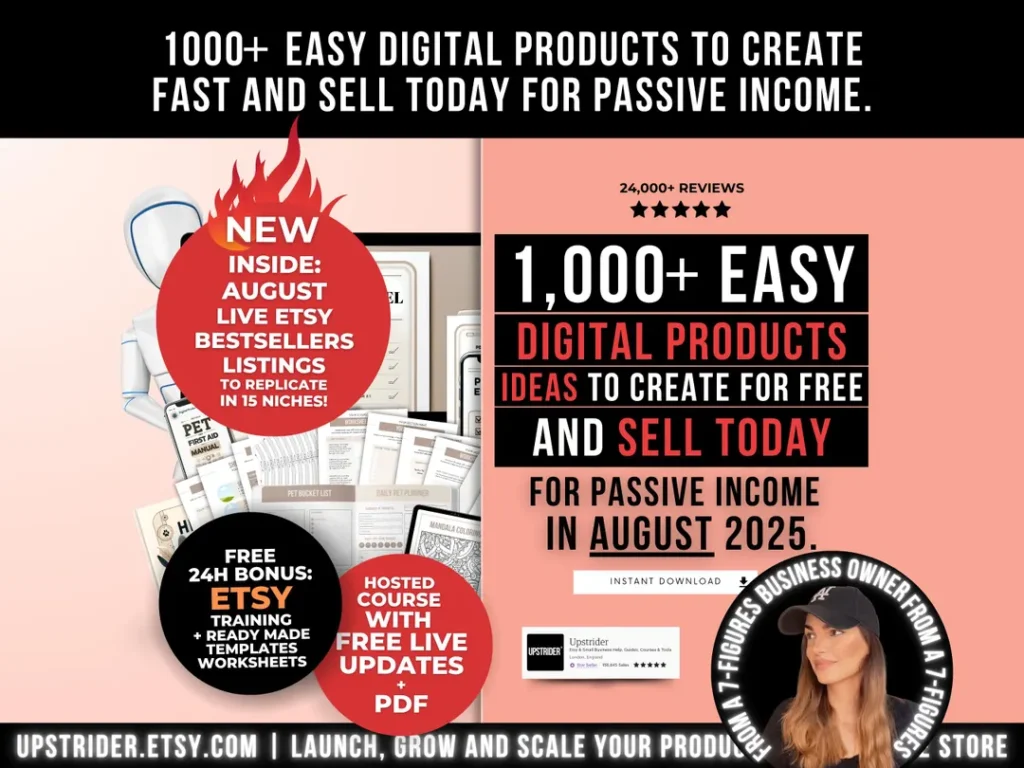
Digital Products to Sell Online: How to Build Passive Income with Courses, eBooks, and More
Estimated reading time: 7 minutes
Key Takeaways
- Digital products can be sold infinitely without running out of “stock.”
- Low overhead leads to higher profit margins compared to physical products.
- Scalability and global reach open doors to unlimited income potential.
- Courses, eBooks, and printables are among the most popular digital offers.
- Automation is key to turning digital products into passive income streams.
Table of Contents
- Introduction
- Benefits of Selling Digital Products
- Types of Digital Products
- How to Create and Sell Online Courses
- Selling eBooks and Printables for Income
- Generating Passive Income with Online Courses
- Best Platforms for Digital Downloads
- Marketing Your Digital Products
- Conclusion
- Call to Action
- FAQ
Introduction
Digital products to sell online—like courses, eBooks, and printables—are intangible yet incredibly powerful tools for generating income. They’re downloadable, scalable, and require no physical inventory, making them ideal for entrepreneurs and creators. This blog post will guide you through creating and selling these digital products. We’ll cover how to build passive income with online courses, how to sell eBooks and printables, and the best platforms for digital downloads. Plus, we’ll share marketing strategies to boost your sales. Let’s dive in.
Stat alert: Over 2.77 billion people shop online yearly, and eCommerce is projected to exceed $6.8 trillion by 2025
[1].
These trends prove one thing: the demand for digital products to sell online is sky-high. And they’re not just popular—they’re profitable. Once created, a digital product scales effortlessly. There’s no printing cost, no shipping, no ongoing production. You can sell one, ten, or ten thousand copies with minimal effort.
Benefits of Selling Digital Products
Low Overhead & Minimal Inventory
- Zero physical costs: No stockroom, no packaging, no shipping labels.
- Better margins: With no upfront costs to reduce per-sale profit, income is doubled.
Scalability & Global Reach
- No location limits: Sell to anyone with internet access.
- Global reach: Over 2.77 billion online shoppers worldwide
[1].
Passive Income Potential
- Repetitive sales: Once created, resell it repeatedly with no extra work.
- Automated income: Use email sequences, webinars, and funnels to sell without constant effort
[2].
(Step-by-step guide)
Types of Digital Products to Sell Online
From courses to templates, digital products come in all shapes and sizes. Here’s a quick overview of the most profitable options:
1. Online Courses
Digital courses are structured learning experiences, often with video lessons, quizzes, and community forums.
- High demand for skill-building topics like business, productivity, or coding.
- Example: Teach “How to Start a Blog for Beginners.”
(Related resource)
2. eBooks & Printables
eBooks (PDF or ePub) and printables like planners, trackers, or checklists are inexpensive to create and deliver.
- Printables: Ideal for niche audiences (e.g., motivational planners or budget trackers).
- eBooks: Pack more depth, making them suitable for complex subjects like self-publishing guides.
3. Additional Digital Downloads
- Notion templates
- Canva design assets
- Stock photos or music
- Software presets or plugins
This variety lets you choose a product that suits digital products to sell online and your skillset
[3].
(9 best side hustles)
How to Create and Sell Online Courses
Building an online course requires planning, creativity, and tech-smarts. Here’s how to do it right:
Step 1: Identify Your Expertise & Course Topics
- Start with what you know, what people need, and what sells. Research through:
- Keyword tools like Google Keyword Planner or AnswerThePublic.
- Competitor analysis: What gaps exist in similar courses?
(Freelance guide) - Profitable niches include business growth, writing skills, or digital marketing.
Step 2: Develop Engaging, Valuable Content
- Break your course into modules (e.g., Week 1: Intro, Week 2: Fundamentals).
- Include video lessons, templates, and community support for user engagement.
Step 3: Record & Produce High-Quality Materials
- Use an HD camera, good microphone, and editing software for crisp video quality.
- Top gear for beginners: Webcam, lapel mic, and lighting kit.
Step 4: Pricing Strategies & Packaging
- Typical prices: $99–$499 for foundational courses, $499–$1,499 for premium ones.
- Offer bonuses like templates or checklists to sweeten the deal
[3].
(Affiliate marketing tips)
Selling eBooks and Printables for Income
If courses aren’t your jam, digital printables and books are an easy alternative. Here’s how to succeed with them:
1. Choose Profitable Niches
- Solve real pain points: Finances, wellness, productivity, or small business.
- Validate with keyword research: Tools like Ubersuggest or Semrush
[3].
(Detailed guide)
2. Design Visually Appealing Printables
- Use clean fonts and fillable fields for user-friendliness.
- Offer multiple sizes (A4 and Letter).
3. Write and Format eBooks for Readability
- Keep it short with clear headings, summaries, and visuals.
- Export in PDF or ePub; include a hyperlinked Table of Contents (TOC)
[3].
(Further reading)
4. Market Your eBook or Printable
- Leverage platforms like Instagram, Pinterest, Twitter, or TikTok for visuals.
- Run ads or partner with influencers to reach buyers
[4].
(Extra tips)
Generating Passive Income with Online Courses
Passive income with online courses is a dream for creators. How does it work?
1. Automated Sales Funnels
Step-by-step process:
- Attract lead via a free resource (e.g., checklist).
- Nurture via email sequence.
- Sell via webinar or mini-course
[3].
(Full approach)
2. Evergreen Content for Long-Term Sales
- Choose timeless topics (e.g., productivity tips or business basics).
- Repurpose content via blog posts or YouTube videos to boost sales
[3].
(Repurposing ideas)
3. Memberships or Subscriptions
- Recurring payments for ongoing access to content.
- Encourage subscriptions by offering exclusive content or community perks.
4. Upsells & Cross-Sells
Bundle your course with templates, coaching services, or advanced modules. This drives up profits per customer
[4].
(More on monetization)
Best Platforms for Digital Downloads
Choosing the right platform for your digital products to sell online is vital. Here’s a quick guide:
1. Overview of Top Platforms
- Teachable: Ideal for courses; complete branding tools and analytics.
- Udemy: Large audience share but limits your pricing and revenue.
- Gumroad: Simple setup; good for printables and books.
- Etsy: Great for printables with built-in buyers, but fees apply.
2. Pros & Cons
| Platform | Pros | Cons |
|---|---|---|
| Teachable | Flexible branding, good support | Monthly fees apply |
| Udemy | Huge discovery, great reach | Restricted revenue percentages |
3. Choosing the Right Platform
- Your audience (how easy are they to reach on the platform?).
- Margins (platform fees can be costly over time).
- Analytics, email tools, and checkout ease.
(Learn more)
Marketing Your Digital Products
Now that you’ve made great products, let’s talk about selling them:
1. SEO Strategies
- Optimize your product pages with keywords like “how to create and sell online courses.
- Use keywords in titles and meta descriptions
[4].
(Beginner SEO tips)
2. Social Media Marketing
Showcase products on Instagram, TikTok, and Pinterest with eye-catching visuals.
3. Email Marketing Campaigns
- Use lead magnets (freebies) to build an email list.
- Send automated sequences that guide people to buy
[4].
(Extra marketing ideas)
4. Content Marketing
Write blog posts about online marketing hacks, or share case studies. This builds trust and guides potential buyers toward your
digital products to sell online
[3].
(More insights)
Conclusion
Is generating passive income with online courses worth it? Yes. Digital products to sell online give you flexibility, scalability, and freedom.
Whether you create courses, selling eBooks and printables online, or other downloads, the options are endless.
- Choose your niche.
- Build a product.
- Pick a platform.
- Launch and automate.
Ready to start? Pick your product and get selling today!
For more, explore stats, templates, and tools here
[1]
[2]
[3]
[4].
Call to Action
Want more tips on how to create and sell online courses or sell eBooks for income? Subscribe here for daily updates and a free printable starter checklist: [Link in bio]
Share this article if you want someone to know how to build passive income with digital products to sell online.
FAQ
Q1: Do I need technical skills to create a digital product?
You can start with minimal tech know-how. Many platforms offer user-friendly tools for creating and marketing digital products. As you grow, you can learn more advanced skills or outsource tasks.
Q2: What’s the best pricing strategy for my first online course?
Begin with a mid-range price, such as $99–$199, to attract beginners. As you add more value, such as live sessions or advanced modules, you can raise the price.
Q3: How do I handle customer support for digital downloads?
Use email or a support ticket system. Most issues revolve around download access or password resets, which can be managed with pre-written templates or tutorials.
Q4: Can I really make passive income from digital products?
Yes. With proper automation—think email funnels, lead magnets, and evergreen marketing—your income can be largely hands-off after the initial product creation.


